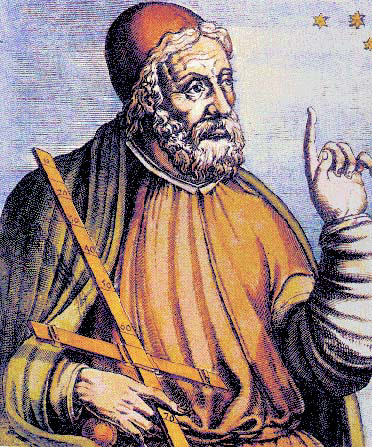
Claudius Ptolemy

Claudius Ptolemy ( Greek: Κλαύδιος Πτολεμαῖος, Klaúdios Ptolemaîos, [kláwdios ptolɛmɛ́ːos]; Latin: Claudius Ptolemaeus; AD 90 – AD 168) was a Greco-Egyptian writer, known as a mathematician, astronomer, geographer, astrologer, and poet of a single epigram in the Greek Anthology. He lived in the city of Alexandria in the Roman province of Egypt, wrote in Koine Greek, and held Roman citizenship.
Claudius Ptolemy was a Greco-Egyptian mathematician, astronomer, astrologer, and writer. He lived in Alexandria in the Roman province of Egypt during the 2nd century and authored several scientific treatises, three of which were of considerable significance to the development of Byzantine, Islamic and European science in later centuries. One of his treatises on geography, which gave a thorough discussion of the geographic knowledge of the Greco-Roman world, was used by the Italian explorer Christopher Columbus as the map for his westward-bound path to Asia many centuries later.
Not much is known about Ptolemy except for the fact that he lived in Alexandria, wrote in Koine Greek, and held Roman citizenship. Whatever reliable facts modern historians know about him have been deduced from the writer’s surviving works. A renowned astronomer of his era, he authored the seminal text the ‘Almagest’ which is a treatise on the apparent motions of the stars and planetary paths. A highly influential scientific text, its geocentric model was accepted for more than 1200 years from its origin. In another astronomical text he detailed what is now known as the Ptolemaic system. Even though his brilliance is widely accepted, scholars in the recent centuries have cast doubts over some of his astronomical observations.
Childhood & Early Life
Not much is known about the circumstances of Claudius Ptolemy’s birth or his family. It is generally believed that he was born around 100 AD in Egypt, Roman Empire. He was of Greek descent, as deduced by his Latin name, Claudius Ptolemaeus.
The 14th century astronomer Theodore Meliteniotes gave Ptolemy’s birthplace as Ptolemais Hermiou in the Thebaid in an uncorroborated statement. However, the general consensus is that he was born in Alexandria where he is believed to have lived and died.
Later Years
Claudius Ptolemy grew up to be a brilliant mathematician, astrologer, astronomer, and writer. Ptolemy was the author of several scientific treatises, and the order of their composition has been deduced from the dates mentioned in his surviving works.
His earliest major work was the astronomical treatise now known as the ‘Almagest’, although it was originally titled the ‘Mathematical Treatise.’ It was completed around 150 AD. The seminal work consisted of 13 sections, each of which covered an important subject.
The ‘Almagest’ was an extensive text which contained an outline of Aristotle's cosmology, the length of the year, the motion of the Sun, the motion of the Moon, lunar parallax, the motion of the lunar apogee, the motions of the fixed stars and planets, among other areas of astronomical relevance.
For drawing his models, Ptolemy adopted Hipparchus' solar model, which consisted of a simple eccentric deferent. He had inherited from his Greek predecessors a geometrical toolbox and a partial set of models for predicting where the planets would appear in the sky.
It is not known for sure how much of the ‘Almagest’ is original. Even though it was a major scientific text, some scholars over the past few centuries have cast doubts regarding its authenticity and have questioned Ptolemy’s credibility as an observer of heavenly bodies.
He authored a significant treatise on geography, called the ‘Geographia’ or the ‘Cosmographia’, a treatise on cartography, compiling the geographical knowledge of the 2nd century Roman Empire. For this work, he relied on the previous works of an earlier geographer, Marinos of Tyre, and on gazetteers of the Roman and ancient Persian Empire. He also cited ancient astronomer Hipparchus in this text.
He designed improvised methods for creating maps and shared his techniques for map drawing in his works. He knew two ways of drawing a grid of lines on a flat map to represent the circles of latitude and longitude on the globe and recorded longitudes and latitudes in degrees for roughly 8,000 locations on his world map.
He was also an astrologer who believed that astrology is a legitimate, though inexact, science. His approach to astrology was quite practical; he thought astrology was useful in some cases, but should not be relied on entirely.
He composed a text on the philosophy and practice of astrology titled ‘Tetrabiblos’ which was considered an authoritative text on the subject for several centuries. The text is credited to have laid down the basic precepts of Renaissance astrology and was made a part of the curriculum in the universities during the Renaissance. The treatise is also described as "by far the most influential source of medieval Islamic astrology."
Ptolemy also had a keen interest in music and wrote the work ‘Harmonics’, on music theory and the mathematics of music. He argued for basing musical intervals on mathematical ratios and wrote about how musical notes could be translated into mathematical equations and vice versa.
A treatise on optics is also credited to him. He wrote about the properties of light, including reflection, refraction, and color in this work which forms a significant part of the early history of optics.
Major Works
Ptolemy’s ‘Almagest’ is one of the greatest scientific texts of all time. It is a critical source of information on ancient Greek astronomy and its geocentric model was accepted for more than 1200 years from its origin. It was translated into several languages over the centuries.
His work ‘Geographia’ was a seminal treatise on cartography in which he provided latitude and longitude co-ordinates for numerous places and geographical features in the world. He also improved the methods of creating maps.
He authored ‘Tetrabiblos’, a text on the philosophy and practice of astrology in which he gave the study of the effects of astronomical cycles on earthly matters. Over the preceding centuries, this influential text was copied, abridged, and translated into many languages.
Personal Life & Legacy
There are few reliable sources of information on Claudius Ptolemy’s personal life. What is known for sure is that he lived and worked in Alexandria and died around 170 AD.
The crater Ptolemaeus on Mars is named after him, as is the asteroid 4001 Ptolemaeus. The Ptolemy Stone used in the mathematics courses at both St. John's College campuses is also named in his honor.
[1]
Sources
Our Mobile Application
Check out Our Mobile Application "Ancient Greece Reloaded"


